Battle for Zendikar Mechanics
It's time once again to adventure on the plane of Zendikar. It's time once again to face the unnatural disaster that is the Eldrazi. And most importantly, it's time once again to check out new Magic cards and learn the abilities found in Battle for Zendikar.
Awaken
The land of Zendikar has always played an important role in its own defense. Some instants and sorceries feature awaken, an ability that lets you animate your lands to join the fight.
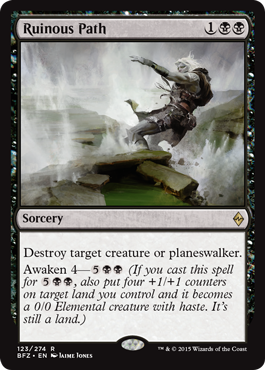
Awaken has two parts: a number and an awaken cost. When you cast a spell with awaken, you have a choice. You can cast it by paying its mana cost as normal. If you do, you'll get its first effect. So if there's a creature or planeswalker bothering you and you have 1BB to spare, you can cast Ruinous Path and go on with your day.
But perhaps you want to have even more fun.
You can also choose to cast a spell for its awaken cost. If you do, you'll also choose a land you control as a target of the spell. When the spell resolves, in addition to the first effect of the spell, the land you chose as the target will become a 0/0 Elemental creature with haste that's still a land. You'll also put some number of +1/+1 counters on the land. So if you have 5BB handy, you can cast Ruinous Path for its awaken cost. That opposing creature or planeswalker will become toast, and you'll have a shiny new 4/4 land creature at the ready. The land keeps its mana abilities, so you can still tap it for mana if you want to. Remember that most lands are colorless, and turning them into a creature using the awaken ability doesn't give them a color.
You might be wondering why the land becomes 0/0 and gets +1/+1 counters instead of just becoming a 4/4 Elemental. Great question! One reason is that you may want to choose a land that's already a creature as the target. Your second Ruinous Path, in addition to annoying your opponent, can target the same land as the first one or a different one. Maybe one 8/8 land creature is better than two 4/4s? Awaken keeps your options open.
There are some caveats: If you cast a spell for its awaken cost, you must choose a legal target for every instance of the word "target," including the one included in the awaken ability. This means you can't cast Ruinous Path without choosing a creature or planeswalker as a target, even if all you want is your land creature. If you cast a spell without using awaken, you ignore the targeting requirement of the awaken ability.
Also, if a spell with awaken normally doesn't require a target, and you choose to cast it for its awaken cost, you will add a target to the spell by doing so. If that target land becomes illegal before the spell tries to resolve, the spell will be countered. You won't get any of its effects, including the first effect that didn't require a target. This won't come up a lot, but it's definitely something to be aware of.
Rally
Allies are back! They first showed up in the original Zendikar block, using teamwork and gumption (yes, gumption) to take on the Eldrazi. They're back in Battle for Zendikar, once again fighting together. Rally is an ability word, so it has no rules meaning, but it's used to highlight abilities that trigger whenever an Ally enters the battlefield under your control.
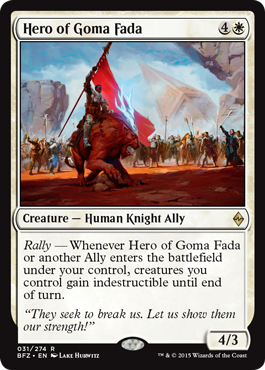
Using rally abilities is pretty straightforward: Pack your deck with Allies and get them onto the battlefield! Every time an Ally enters the battlefield under your control, all your rally abilities will trigger. You can put those abilities onto the stack in any order. The last ability you put on the stack will resolve first, and so on. If an Ally with a rally ability enters the battlefield under your control at the same time as other Allies, that ability will trigger once for each of those Allies and once for the creature with the ability itself.
Ah, gumption.
Converge
It's kind of "all hands on deck" for Team Zendikar, and converge illustrates how all the residents of Zendikar are coming together. Another ability word with no rules meaning, converge highlights spells whose effects depend on the number of colors of mana you spend to cast them.
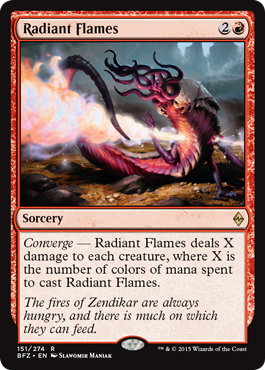
To cast Radiant Flames, you have to pay 2R. So, you're pretty much locked in to at least one color, but you can pay for the other two in a variety of ways. Perhaps you spend all red mana to cast Radiant Flames. Then it will deal 1 damage to each creature. But if you spend three different colors, say BRG or URW, Radiant Flames will roast creatures for 3 damage.
You are limited to the mana cost of each spell. You can't pay WUBRG to cast Radiant Flames, no matter how much you want to torch everything for 5. But, if an effect imposes an additional or alternative cost to cast a spell with converge, you always look at the mana you actually spent. So if spells you cast cost one more to cast for some reason, now you can get Radiant Flames to 4 damage. But it works if spells you cast cost less mana to cast also. If spells you cast cost one less to cast for some reason, you're going top out at 2 damage.
Be aware that if a spell with converge on the stack is copied, it's just created on the stack. No mana was spent to cast the copy, so zero colors of mana were spent to cast it. The copy probably won't have much of an effect.
Landfall
Landfall was a powerful mechanic from the original Zendikar block, and it's back for more. Another ability word, landfall abilities trigger whenever a land enters the battlefield under your control.
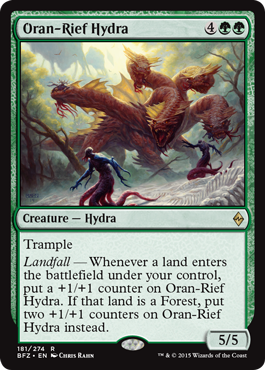
Landfall abilities trigger no matter how the land is entering the battlefield under your control. It could be because of your normal land play. Maybe an effect lets you put a land onto the battlefield. It doesn't matter. Each land causes all your landfall abilities to trigger, and you choose the order. Some landfall abilities, like Oran-Rief Hydra's, even have bonus effects if the land that entered has a particular basic land type. That's not just cards named Forest. Any nonbasic land that has the type Forest that you happen to come across will get you two +1/+1 counters on Oran-Rief Hydra.
We've heard a lot about the Zendikari side of this conflict. But maybe you side with the Eldrazi. Well, you're a monster, but you get some cool new abilities too. For example. . .
Ingest
Ravaging entire planes requires a lot of energy. Ingest is a new ability that gives you just the fuel you need. (You'll see.)
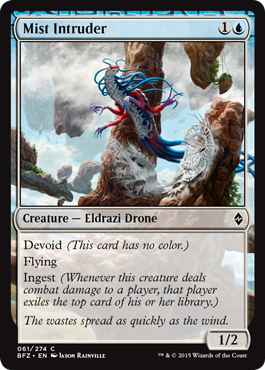
Ingest is a pretty straightforward ability. A creature with ingest deals combat damage to a player, and the top card of that player's library is exiled. Eaten. Ingested. You get the idea. The card is exiled face up. Ingest depletes your opponent's library, but the Eldrazi probably have something better in mind (or whatever passes for minds with them). In fact, they do.
Processors
In this set, cards your opponents own in exile are pretty useful. Look for Eldrazi in this set with the additional creature type Processor. Each one has an ability that requires you to put your opponent's exiled cards into their graveyard for some effect. (There's also one sorcery that does this as an additional cost, and it has "Processor" in the name. Clever, huh?)
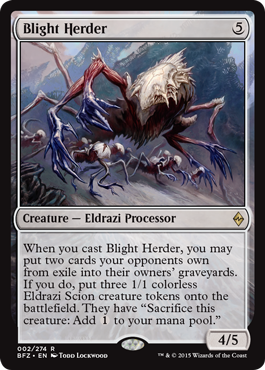
The timing of when you put the cards into the graveyard can vary, and each effect is different. Read your cards carefully to learn the specifics. For example, Blight Herder's ability triggers when you cast Blight Herder. That ability will resolve before Blight Herder does.
You can't "process" cards you own, only ones an opponent owns. In a multiplayer game, if the card asks you to process more than one card, you can choose cards owned by different opponents.
Did you notice that Blight Herder creates Eldrazi Scion tokens? So did I! Let's learn a bit more about them.
Eldrazi Scions
In the Rise of the Eldrazi set, we were introduced to Eldrazi Spawn: 0/1 creatures that could be sacrificed for mana. Useful little buggers. Good for blocking or ramping into giant Eldrazi. Didn't attack much though. Well, there's been a small improvement.

Eldrazi Scions are very similar to Eldrazi Spawn. They're created by Eldrazi-themed spells in a variety of ways. Sometimes it's an enters-the-battlefield triggered ability. Sometimes it's a "dies" triggered ability. Sometimes it's a sorcery. No matter how they're created, Eldrazi Scions all have the ability "Sacrifice this creature: Add 1 to your mana pool." This is a mana ability that doesn't use the stack and can't be responded to, just like tapping a land. And perhaps more importantly, Eldrazi Scions are 1/1. Happy attacking!
Devoid
Eldrazi sometimes don't play nicely with the colors of mana. Some Eldrazi in this set have an ability called devoid.
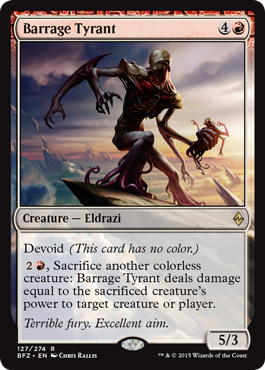
A card with devoid is colorless, even though it has colored mana in its mana cost. Barrage Tyrant is a colorless card, not a red card. Devoid works in all zones, so if a card instructs you to search for a colorless card in your library, you can find Barrage Tyrant. And as Barrage Tyrant's ability demonstrates, being colorless can be quite the advantage in this set. Each card with devoid has a special frame that honors its colorlessness while still hinting at the colors of mana you'll need to actually cast it.
Cards with devoid aren't the only ones getting in on the colorless act. Some of the larger Eldrazi and some Eldrazi-themed instants and sorceries are colorless the old-fashioned way—by not requiring colored mana to cast.

Don't forget that the "true colorless" creatures aren't artifacts. They just don't have any colors.
And there you have it. One deadly conflict. Two formidable sides. Like a bajillion cool plays. Get ready for quite a ride.

